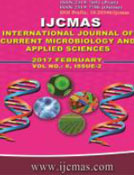


 National Academy of Agricultural Sciences (NAAS)
National Academy of Agricultural Sciences (NAAS)

|
PRINT ISSN : 2319-7692
Online ISSN : 2319-7706 Issues : 12 per year Publisher : Excellent Publishers Email : editorijcmas@gmail.com / submit@ijcmas.com Editor-in-chief: Dr.M.Prakash Index Copernicus ICV 2018: 95.39 NAAS RATING 2020: 5.38 |
The study aimed to evaluate oxidative stress status in cattle breeds of different thermotolerance during different seasons. Ten each of Tharparkar (Bos indicus) and Karan Fries (Bos indicus x Bos taurus) heifers were selected from NDRI herd, Karnal. Animals were maintained under standard managemental practices followed at the farm. Blood samples were aseptically collected from each animal during winter, spring and summer. Oxidative stress markers (ROS, GPx and SOD) and heat stress markers (HSP70.1 and HSP70.2) were determined by ELISA. In both the breeds, higher (P<0.05) levels of ROS, GPx, SOD and HSP70s were observed during summer followed by winter and spring. Breeds showed no significant difference during winter and spring. During summer, ROS, antioxidant enzymes and HSP70s were higher (P<0.05) in Karan Fries than Tharparkar. The study concludes that plasma levels of ROS, antioxidant enzymes and HSP70 were strongly affected by seasonal change in temperature. Plasma stress markers can be used for evaluation of the effect of thermal stress on oxidative status of cattle. Summer conditions capable of producing heat stress cause oxidative stress in cattle. Higher generation of oxidative stress in Karan Fries might be an important factor for their greater sensitivity to heat stress than Tharparkar.
 |
 |
 |
 |
 |